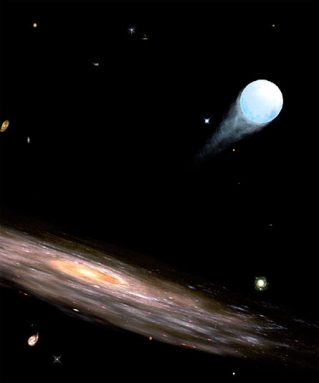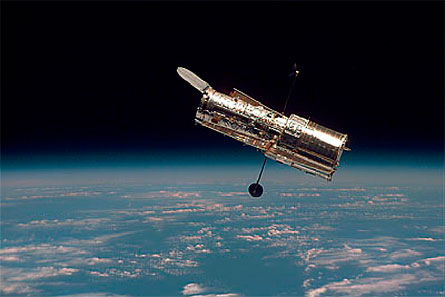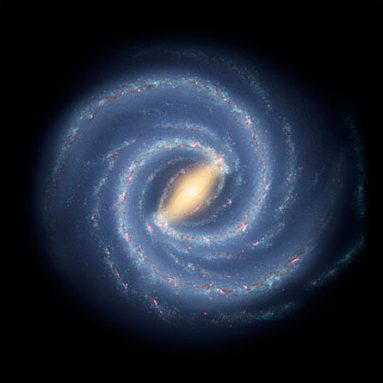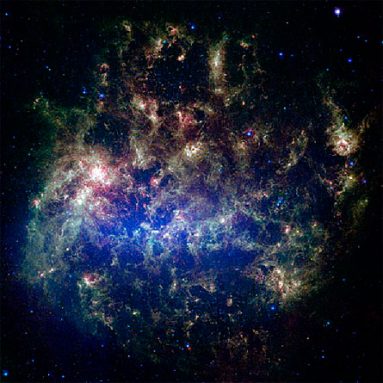Speedy stars
A gang of stars on the edge of our galaxy is running away.
 |
|
Hypervelocity stars are young and fast, and they’re on their way out of the galaxy.
|
| Ruth Bazinet, Harvard-Smithsonian Center for Astrophysics |
Think stars don’t move? Think again! When you look into the sky at night, the stars may appear to stay in place. But stars are always on the move — they’re just so far away that the motion is hard to see.
But some stars move in ways that appear too weird to be real. In 2005, astronomer Warren Brown found one of these space oddities. It was located on the outer edge of the Milky Way, the galaxy we live in. The star was speeding away like nothing he’d ever seen.
“It seemed absurd. No star in the galaxy has a speed like that,” Brown remembers. He’s an astronomer with the Smithsonian Astrophysical Observatory in Cambridge, Massachusetts. “I thought, oh my goodness, I have something kind of special here.”
No one had ever seen a star like this one. What does a scientist do when the results don’t make sense?
Brown didn’t give up. Instead, he kept looking. And he kept finding more of these strange and speedy stars, called hypervelocity stars. Hypermeans “above” and velocity has to do with speed. He and his team just found six more of these “above speed” stars, bringing the total to 16. And, he says, he’s found even more, and is just waiting for the scientific community to confirm them.
When he found the first hypervelocity star, Brown had a hard time believing his own results. And for good reason. He measured the star’s speed to be about 1.6 million miles per hour. That’s fast enough to escape the galaxy and fly away into deep space. If an airplane could fly that fast, it would be able to circle our planet in about one second.
To make matters worse, the star wasn’t flying around the galaxy, like most stars. Instead, it was flying out, like a pop fly that just keeps going up, up, up, out of the ballpark and out of sight. Not only was the star going faster than anyone had ever seen a star move, it was going in the wrong direction.
Brown estimates that there are about 10,000 hypervelocity stars on their way out of the galaxy. Ten thousand may seem like a lot, until you consider that there are hundreds of billions of stars in the Milky Way. If you were to pick a star at random, the chance that it is a hypervelocity star would be about 1 in 10 million.
 |
|
One of the world’s most powerful telescopes is orbiting Earth. The Hubble Space Telescope, shown here, is the size of a school bus. Hubble is currently suffering some technical problems. Next year, astronomers plan on using the telescope to look for more hypervelocity stars — as long as it’s been fixed!
|
| Hubble |
Binary stars and black holes
How did the stars get to the outer edge of the galaxy in the first place? To find out, astronomers like Brown are piecing together a galactic puzzle with surprising pieces. One of these pieces is a giant black hole. More pieces are pairs of stars called binaries. The idea holding these pieces together is gravity.
Gravity is a force that physically attracts any objects with mass. The more mass an object has, the more gravity it has. So more massive objects pull toward them lighter objects. The gravity of the Earth, for example, keeps your feet on the ground. The Earth’s large amount of mass also attracts the moon, keeping it in orbit. But the mass of the sun is large enough that its gravity attracts Earth, keeping it in orbit. The sun’s mass and gravity attracts everything else in our solar system. Gravity exists on smaller scales, too. There is a gravitational force between you and your pencil — or even you and your teacher! (But not enough for your pencil to go into orbit around you.)
All stars have mass, which means they all have to obey the laws of gravity. Stars are born in clusters, and they are often born close enough to another star that the stars stay together, like twins or a pair. Because of gravity, the two stars end up circling each other while traveling through space. As they whiz through space, they’re always bound to each other. These types of stars are called binary stars.
Imagine two tennis balls connected by a rubber band. The rubber band is like gravity. If you hold one of the tennis balls and swing the other in circles over your head, you can get an idea of what these stars look like as they circle each other. (Don’t do this if anyone is nearby, of course.)
What do binary stars have to do with hypervelocity stars? They might be the same thing — or at least half of the same thing.
From the inside out
In 1988, an astronomer named Jack Hills suggested a wild idea. Hills was a physicist, a scientist who studies things like gravity, at the Los Alamos National Laboratory in New Mexico. He said that if binary stars came too close to a giant black hole, the hole might capture one of the stars and keep it in orbit forever — and fling the other one out into space, at a high speed. A black hole is one of the most bizarre things in outer space: It’s very small, but it might have as much mass as billions of suns. The gravity of a black hole is so strong that not even light can escape. Remember the tennis balls? Imagine that, as you swing one of the balls over your head, someone sneaks up behind you and cuts the rubber band. Bye, bye, tennis ball!
And bye, bye, stars! “If you have a binary coming close to the black hole, one goes flying out and the other is thrown into the mass of the black hole,” says Alceste Bonanos, an astronomer at the Space Telescope Science Institute in Baltimore, Maryland. In other words, when the black hole captures one of the stars, it disrupts the gravity between the two stars. And the “free” star has so much energy that it can fly away from the other star and the black hole.
Hills’ idea was presented long before astronomers found any hypervelocity stars. Brown says he believes that Hills’ idea about these stars is right. “They’re hard to explain in any other way except a black hole,” he says.
 |
|
Our galaxy, the Milky Way, is shaped like a spiral. Astronomers believe that the bright spot in the middle actually hides a giant black hole millions of times as massive as our own sun.
|
| NASA/JPL-Caltech |
A giant black hole, more massive than 3 million suns, lurks at the center of our galaxy. The black hole’s gravitational force is so strong that it keeps the entire galaxy together. The hole’s force also has the power to separate binary stars. Astronomers blame the black hole at the center of the Milky Way for most of the known hypervelocity stars. The disruption of a binary star doesn’t happen very often, but when it does, one of the stars gets blown out of the galaxy, becoming a hypervelocity star.
“We’re measuring stars [that were] ejected by a central black hole over a couple million years,” Brown says. “We think they come out every 10 million years or so.”
In addition to being space oddities, hypervelocity stars may help astronomers understand more about the Milky Way’s black hole. Hypervelocity stars might be easier to see than the stars near the center of our galaxy.
“It’s hard to study stars at the galactic center,” Bonanos says. If hypervelocity stars really did come from there, then they’ll be easier to study than the stars they left behind, near the black hole. By studying the chemical makeup of hypervelocity stars, astronomers will better understand the kinds of stars that are trapped near the black hole.
The strangest of the strange
Not all hypervelocity stars are alike. In fact, Bonanos thinks one of them may not even be from our galaxy. She and her team spent some time studying the light intensity of one of the stars, called HE 0437-5439. Earlier this year the team produced some surprising results.
Like other hypervelocity stars, HE 0437-5439 was found on the outer edges of our galaxy. But Bonanos found a problem with the star’s age. It was actually younger than the amount of time it would have taken the star to fly out of the center of the Milky Way. “The travel time that it took from the galactic center to where we see it today is three times longer than how long these stars typically live,” Bonanos says.
Why is this so weird? It would be a little like meeting someone on the street who fought in the Civil War, which happened almost 150 years ago.
 |
|
One hypervelocity star might have come from here, the Large Magellanic Cloud. This galactic neighbor is the brightest galaxy visible in the night sky (mainly in the Southern Hemisphere).
|
| NASA/JPL-Caltech/M. Meixner (STScI) & the SAGE Legacy Team |
Bonanos and her colleagues think the star may have been flung to the edge of our galaxy from the Large Magellanic Cloud, a galaxy 179,000 light-years away. If that’s true, then this hypervelocity star suggests that the Large Magellanic Cloud also has a black hole at its center. It will be years before astronomers know this for sure, though.
Not so fast!
Some astronomers think that the hypervelocity stars puzzle may be even more complicated. Not everyone believes that a black hole is responsible for all these kinds of stars.
“The accepted scenario is the black hole,” says Julio Navarro, an astronomer at the University of Victoria, in Canada, “but there are some problems with that scenario when confronted with the data.”
Navarro doesn’t rule out the possibility of a black hole causing hypervelocity stars. But he and his colleagues recently proposed an alternative explanation. They suggest that the stars were actually once part of a dwarf galaxy that collided with the Milky Way.
Navarro likens the collision to an intergalactic wedding. “In the dwarf galaxy’s marriage with the Milky Way, some stars were ejected in, some out,” he says. Most of the dwarf galaxy’s cosmic material gets tossed into the center of the Milky Way, but some gets ejected out.
Navarro says his idea will be easy to test in the future, after more stars have been discovered. But it will take astronomers years to find enough hypervelocity stars to really understand whether they came from a black hole or a cosmic crash — or some from each.
That’s where Brown, ever looking to the sky, comes back in to the puzzle. Armed with new telescopes and new ideas, he is continuing to look for more hypervelocity stars.
“I think we can say a lot more in five years than what we can say now,” he says.
“The future of hypervelocity stars is unbound.”







